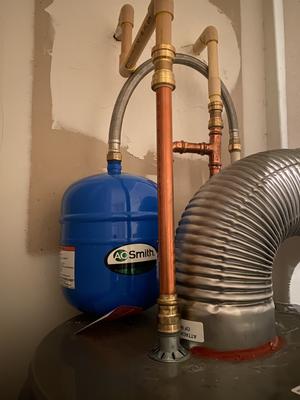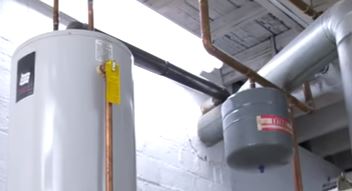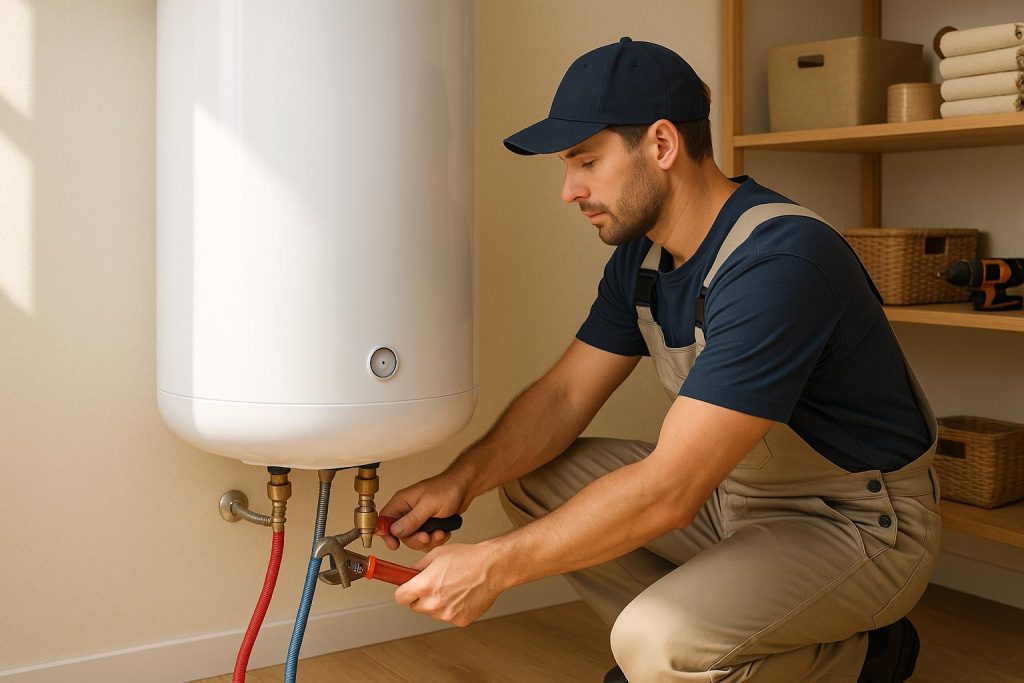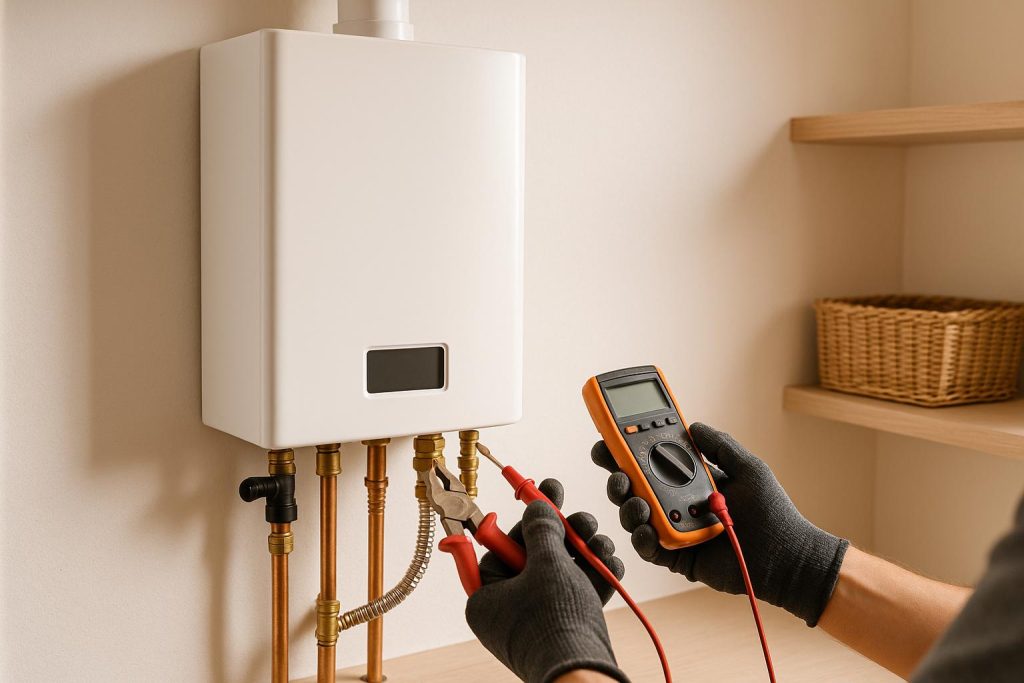A water heater expansion tank is a small tank with an air bladder installed between the water heater and the cold water pipe shut off valve to absorb excess pressure from the water heater tank.
It helps to prolong the life of the water heater, stop hot water pressure fluctuations, prevent/stop a leaking T&P valve, and also prevent damage to other appliances.

You need to install a water heater expansion if your house has a closed-loop system (due to a check valve or pressure reducing valve). If you have a hot water recirculation system, your T&P valve is always leaking, or you hot water pressure fluctuates you also need one. In some states water expansion tanks are required by code.
How a Water Heater Expansion Tank Works
So, what is the purpose of a water heater expansion tank and how does it work?
A water heater expansion tank is a small tank, about 2 gallons in volume (for a 50-gallon water heater) and made of steel. They are usually blue or off-white/grey in color.
Most importantly, they are installed on the water heater’s cold water supply pipe between the water heater and the shut off valve. A tee is installed in the system which allows the installation of this tank.
Inside the water heater expansion tank there are 2 compartments separated by a bladder/diaphragm. The top part is filled with air while the bottom part is filled with cold water from the supply pipe.
There is an air inlet valve at the top of the tank which allows you to fill the top compartment with air, whose pressure should be equal to that of the cold water coming into the heater. In short, the top section of the expansion tank looks like a balloon.
When cold water flows into the water heater, it is heated leading to thermal expansion. If there is no instant demand for hot water in the house, the hot water (now under pressure) will try and flow back in the cold water pipe.

If you have a check valve or pressure reducing valve (PRV), the water cannot flow back and is hence stored under pressure in the water heater. And that is where the water expansion tank comes in.
The purpose of a water heater expansion tank is a shock absorber for the water heater where the hot water pressure compresses the air chamber at the top of the tank, stabilizing the water pressure inside the water heater.
Without the expansion tank you will notice that water gashes out if you turn on a hot water faucet and then stabilizes after a few seconds. That kind of pressure will damage valves and hoses in some house appliances like dish washers and washing machine.
Do You Need a Water Heater Expansion Tank?
In some areas like California and Texas, new water heater installations need to have an expansion tank as per the code. Some water heater manufacturers are now also requiring it, and failure to install one can deem your warranty claim null and void.
What if you already have a water heater in place? Should you install a water heater expansion tank? The following are the instances when you need to have a water heater expansion tank installed.
1. You Have a Closed-Loop System

A closed-loop plumbing system simply means that water in your plumbing pipes can only flow in one direction. This is made possible through the installation of a check valve or pressure reducing valve.
In the past, expanding water in the water heater would simply flow back through the cold water supply line and into the municipal city’s supply pipes. That is however not acceptable presently as backflow from home has the potential to contaminate the city water.
Modern meters are fitted with a check valve meaning water can only flow to your house and not out of it. This is what creates a one-way or closed loop system.
A pressure reducing valve is a device usually installed close to the water meter. It controls the pressure of water coming into your house. The acceptable water pressure in the house is between 40 and 70 psi.
If the pressure exceeds 80 psi, it will cause premature failure of some household appliances like toilet fill valves, faucet washers, dishwasher and washing machine water supply houses among others.
Another thing to remember is that if your house has a hot water recirculation pump installed then definitely you have a check valve. The check valve prevents cold water from back to the hot water pipes, which creates a closed loop.
2. Leaking Temperature and Pressure Relief Valve

Water heaters are equipped with temperature and pressure relief valve to help them discharge excess water (pressure) from the tank. The pressure rating of a water heater T&P valve is 150 pounds per square inch (psi).
A temperature and pressure relief valve can leak for 2 reasons. Either it is defective, or the water pressure inside the tank exceeds that of the T&P valve rating.
If your temperature and pressure valve is always leaking, replacing it will not fix the problem. The only permanent fix will be installing a water heater thermal expansion tank to absorb the extra pressure.
A water temperature and pressure relief valve can leak also if the water pressure in your house is too high, in most cases more than 80 psi. In that instance, installing an expansion tank will do nothing to fix the problem.
You will first need to have a pressure reducing valve installed, which will control the pressure of the entire house and not just water flowing to the water heater. If you have a pressure control valve in place but still your T&P valve is leaking, now you can install a thermal expansion tank.
To check the water pressure in your house, connect a pressure gauge to an outside spigot and turn on the valve. You can also connect it to the water heater’s drain valve to check the pressure of water inside the tank.
People using water from a well often ask if they need to install a water heater expansion tank. Most don’t see the need to.
If you are using water from a well and have a check valve between the pressure tank and the water heater, you have a closed system and you definitely should install a water expansion tank. If you don’t have a check valve then an expansion tank is not needed.
How to Size a Water Heater Expansion Tank
It is important to know the size of thermal expansion tank that will work with your water heater. These tanks are not a one-size-fits-all installations. The size of the expansion tank is directly proportional to the volume of the water heater.
An expansion tank that is too small will do nothing to fix the hit hot water pressure fluctuations or leaks in your fixtures. On the other hand a tank that is too large is not cost-effective. Bigger is however always better than smaller.
Apart from the size/volume of the water heater, the correct size of the water heater expansion tank also depends on the pressure of the incoming water. The higher the pressure the bigger size of expansion tank you need.
Each water heater expansion tank manufacturer has their own model numbers for their different expansion tank sizes. The chart below indicate the size of A .O. Smith thermal expansion tanks needed for different sizes of water heaters and at different water pressures.
[wptb id=544]
How to Install a Water Heater Expansion Tank
Installation of a water heater expansion tank is a job better left to licensed plumbers but if you are a confident DIYer then you can definitely do it.
The first thing is selecting the right size of thermal expansion tank and the right size of tee. Measure the existing size of your existing cold water pipe and buy the exact size of copper pipe tee. Most of the time this pipes are 3/4 inches.
To install an expansion tank, you will just need to add a tee on the cold water pipe between the shut off valve and the heater. You will also need to drain some water from the heater to release excess pressure, otherwise it will gush out when you loosen the cold water pipe.
Hot Water Heater Expansion Tanks Maintenance
Water heater expansion tanks lasts for 5 years on average, depending on how well they are made, quality of the water, installation workmanship among others. Tanks in areas with hard water lasts for fewer years than those in areas with fresh water.
A properly installed tank will also last for longer than one that was poorly installed. If your thermal expansion tank is undersized, the bladder will always be under very high pressure and will fail quicker than a properly sized tank.
A bad/failed water heater expansion tank will either be leaking water around the cold water pipe connection, or it will be waterlogged. Waterlogging happens when the bladder ruptures causing the entire tank to be filled with water.
The main telltale sign of a failed/bad water heater expansion tank is a leaking temperature and pressure valve. In this case, the tank is usually water logged and since water cannot be compressed it will force its way out of the T&P valve.
Another sign is fluctuating hot water pressure. Hot water gashes out when you turn on a faucet or shower and then stabilizes after a few seconds. The sudden gush of water is a sign that there is excess water pressure in the water heater which is being bled off.
So, how do you know if your water heater expansion tank is working properly? The first thing you need to do is to check the connection between the tank and the cold water pipe.
If it is corroded, your thermal expansion tank could still be working properly but is at risk of leaking soon. Call in a plumber and have it replaced especially if it is older than 5 years or out of warranty.
A properly working water heater expansion tank feels hollow at the top but solid at the bottom (assuming the connection is at the bottom). Tap the top and bottom of the tank and listen keenly. If the entire tank sounds solid all through you have a bad expansion tank.
The other test you can perform is to try and bleed pressure from the tank. Remove the small cap at the top and gently press inside the pressure inlet valve with a finger. If pressure (and not water) escapes then the bladder integrity is intact.
To check the air pressure in the water heater expansion tank:
- Connect a water pressure gauge on any of your faucet and open it. Note down the pressure.
- Turn off the water heater’s cold water pipe shut off valve.
- Open the nearest hot water faucet and run it run out. This will release the water pressure stored in the water heater and also that in the thermal expansion tank.
- Connect a pressure gauge on the water heater expansion tank inlet valve. Compare that pressure to that of the water being supplied to the house. As a rule of thumb, both of this pressures needs to be the same. If the air pressure in the tank is low add it up with a compressor or a bicycle pump.
- Open the cold water pipe shut off valve.
Please note that if the pressure charge inside the water heater expansion tank is too low, its efficiency will be greatly compromised and you will still experience fluctuating hot water pressure and/or a leaking temperature and pressure valve.





